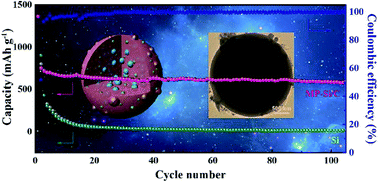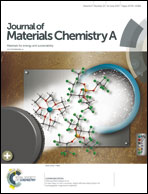Encapsulating silicon nanoparticles into mesoporous carbon forming pomegranate-structured microspheres as a high-performance anode for lithium ion batteries†
Abstract
It is a research hotspot to develop advanced anodes with high capacity and good high-rate cyclability for lithium ion batteries. In this work, we develop a facile way to design and fabricate a silicon/carbon spherical composite by encapsulating Si nanoparticles into a mesoporous carbon matrix via a one-step hydrothermal method. Interestingly, the pomegranate structure is realized in the silicon/carbon (Si/C) composite spheres, in which Si nanoparticles of 50–100 nm are just like “pomegranate seeds” embedded into the mesoporous “pomegranate carbon chamber” with pores of 3–4 nm. This unique porous pomegranate structure can not only ensure good electrical conductivity for active Si, but also accommodate the huge volume change during cycles as well as facilitate the fast diffusion of Li ions. When evaluated as an anode for LIBs, the designed pomegranate-structured Si/C composite spheres deliver an excellent cycling stability of 581 mA h g−1 at a current density of 0.2 A g−1 after 100 cycles and achieve a noticeable high-rate capacity of 421 mA h g−1 even at a high current density of 1 A g−1, much better than those of the bare silicon electrode. Our developed facile synthetic strategy shows a new way for large-scale production of high-performance anodes for electrochemical energy storage.



 Please wait while we load your content...
Please wait while we load your content...